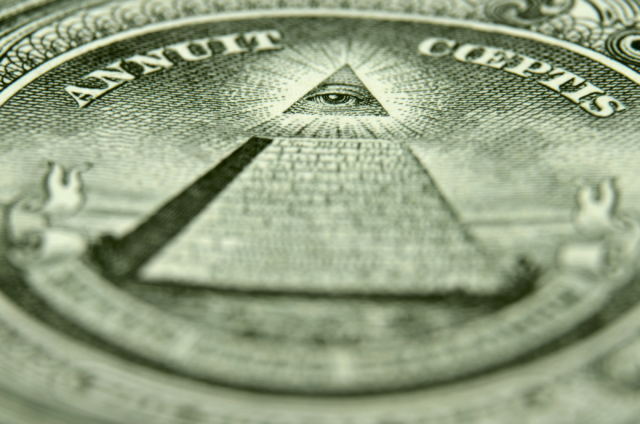from the article here
“While many point to the Freemasons and Illuminati as the source for this particular symbol, there is another organization behind it- one that has for centuries worked tirelessly to bend governments the world over to their will. We are, of course, talking about Christianity.
While many a conspiracy theorist today will say the Eye of Providence represents Satan, in truth, it has represented God watching over humanity for at least a half a millennia or so. Beyond God’s eye, the commonly added triangle around the eye represents the trinity (Father, Son, and the Holy Spirit). As for the sun rays also commonly shown around the eye, this is meant to represent God’s divinity. You can see a prime historic example of this in Jacopo Pontormo’s 1525 painting Supper of Emmaus, as well as on many historic church buildings’ stained glass windows and the like.
So how did this Christian symbol end up on the dollar bill?
When the Continental Congress kicked King George III to the curb, they needed an official seal for the new nation. Towards this end, they tasked Ben Franklin, Thomas Jefferson, and John Adams with creating one. These three titans of American history, in turn, enlisted the aid of an artist named Pierre Eugene du Simitiere to help out.
As for Franklin, he pushed for a seal that, in his own words, depicted “Moses standing on the Shore, and extending his Hand over the Sea, thereby causing the same to overwhelm Pharaoh who is sitting in an open Chariot, a Crown on his Head and a Sword in his Hand. Rays from a Pillar of Fire in the Clouds reaching to Moses, to express that he acts by Command of the Deity.”
The motto he wanted on the seal was “Rebellion to Tyrants is Obedience to God”, a motto Jefferson would eventually use on his own personal seal…. du Simitiere suggested a shield with the initials of the thirteen states on it. Flanking the shield was a female representation of Liberty holding an anchor and a spear. On the other side, stood a man holding a rifle and a tomahawk. Above it all is the Eye of Providence in a triangle, with sun rays shining down, indicating God being on the side of the new nation.
Du Simitiere also went with E Pluribus Unum, “Out of Many, One”, for the motto. This slogan was borrowed from The Gentleman’s Magazine, which used it to represent many articles collected from various outlets and put into one magazine….
Hopkinson went ahead and adopted the shield concept, but modified it to just show thirteen stripes. Most notable to the progression of the seal, he also included an olive branch, an arrow held by an Indian man, thirteen stars, and included a slogan of “Bello vel pace paratus”, meaning “Prepared in war or in peace.” Finally, he included the date of 1776 in Roman numerals.
Beyond this version, he also came up with a second one, but both were eventually rejected and the matter once again tabled.
While you might think the third time would be a charm… not so much. About two years later, in May of 1782, Congress tasked John Rutledge, Elias Boudinot (who would be replaced by one Arthur Lee), and Arthur Middleton, with creating the seal. Yet again, the trio brought on board someone else to do the actual work- in this case a lawyer by the name of William Barton.
Most pertinent to the progression here, his design included, among other things, an eagle, and on the reverse a pyramid with the Eye of Providence above it, though without the triangle that had been present in the first committee’s version….
Borrowing something from all the previous designs, what he eventually came up with was as follows: Besides the shield with stripes representing the states, he depicted a bald eagle holding an olive branch in one talon, representing peace. In the other talon the eagle is holding 13 arrows, one each for the original 13 states, with the arrows representing the United States’ readiness to fight to protect its interests. However, the eagle’s head is turned towards the olive branch, symbolic of the nation preferring peaceful relations.
Further representing the 13 original states are 13 stars over the eagle’s head. The final motto chosen was the aforementioned very fitting E Pluribus Unum.
On the reverse side of the seal is Barton’s unfinished pyramid, with said pyramid representing, as Thomson himself notes, “strength and duration”. The 13 layers represent the 13 states which comprise the nation. The eye of providence at the top, as mentioned, represents God watching over the nation.
The text Annuit cœptis is also included, roughly meaning “He (God) has favored our undertaking”. On the bottom is the text, Novus ordo seclorum, meaning roughly “A new order of the ages”, inspired from a line in Virgil’s Eclogue IV.
Also included at the base of the pyramid are the Roman Numerals for the year of the establishment of that new order- 1776.
And so it was that on June 20, 1782, Congress approved Thomson’s design based on the description alone, as at this point Thomson hadn’t actually drawn it up yet, simply giving descriptive notes and the thought process behind each element.
Of course, for those who don’t want to trust the guy who designed it, an alternate hypothesis as to the origin and symbols used here is succinctly outlined in an article titled “Satan on the United States Dollar”. To quote said article,
First of all I will interpret the Latin words on the seal. ‘Annuit Coeptis’ means ‘Announcing The Birth Of’ and ‘Novus Ordo Seclorum’ means ‘New World Order’. So therefore it says ‘Announcing the birth of the New World Order’. The date in roman numerals is 1776, the year the modern Illuminati was formed and also the year of American independence. The Latin ‘E Pluribus Unum’ means ‘One out of many’ (that is, order out of chaos) which is the foundation of the New World Order’s plan to unify the world’s governments, religions and money systems into one so the world can be controlled. WHY THE ANTICHRIST MUST COME SOON!!!
The capstone has not come down on the Pyramid. This means that the plan is not complete. Only when the New World Order is established upon all nations and the world leader is enthroned the plan will be complete….
This finally brings us to the creation of the $1 bill. First issued in 1862, unlike the dollar bill of modern times, this did not sport the Eye of Providence, nor even George Washington. Rather, it showed a guy by the name of Salmon P. Chase, the Secretary of the Treasury at the time who apparently saw his chance for history to remember him and took it!
…Fast-Forwarding about a half century, a slew of changes to the dollar bill over the course of a decade or so ultimately saw the Eye of Providence added in 1935.
The idea behind this particular change, one of the last to the dollar bill, came from then Secretary of Agriculture (and future Vice President) Henry Wallace.
The inspiration here for Wallace came from reading a copy of a 1909 work by Gaillard Hunt, which gave a detailed account of the genesis of the United States seal. Most pertinent to the topic at hand is that it included image copies of not just the front of the seal, which many people were familiar with, but the reverse with the pyramid. At the time, this was largely unknown and unused. In fact, Wallace, while he was a Freemason so familiar with the Eye of Providence from that as well as its prominence in Christianity, himself had never seen the reverse of the United States seal before.
Not just liking the imagery, Wallace also noted that the “Novus Ordo Seclorum” (“New Order of the Ages”) motto of the American government, could be tied into Roosevelt’s own “New Deal”- hence “New Deal for the Ages”.
Thus, Wallace suggested Roosevelt have the reverse side of the U.S. seal put on a coin. Roosevelt loved the idea, but decided to put it on the dollar bill instead.
However, before going through with it, he first ran the idea by his cabinet, among other potential objections wondering if any religious group would be offended by putting a Christian symbol on the dollar, or conversely if any Christian group might see it as him trying to put a version of a Freemason symbol there….

Since the addition of the U.S. seal imagery in 1935, the dollar bill has changed little, other than “In God We Trust” added in 1957 to further double down on the religious theme, among other very minor modifications. As counterfeiters rarely target the $1 bill, unlike the other bills that have frequently had security updates to their design in recent decades, the dollar bill hasn’t really changed much since this 1935 edition, and seemingly won’t anytime in the near future until (apparently) the New World Over is finally completely established and the top of the pyramid will need reworked…”
